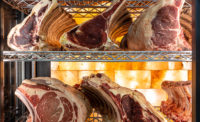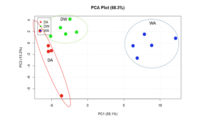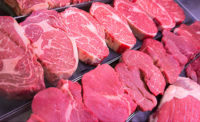Meat Science Review
Effects of dry aging on color and oxidation stabilities of beef loins

Figure 1: Discoloration scores
The graph shows discoloration scores of steaks from beef loins assigned to different aging types after seven days of retail display under light.
WA: wet-aged; DA: dry-aged; DAW: dry-aged in a bag
1 = no discoloration, 7 = 100 percent discoloration;
* = significantly higher)
Dry aging, whereby storing whole beef carcasses or unpackaged primals/subprimals in a controlled cooler, has been practiced for decades as a traditional butchery process. Due to its known positive impacts on palatability attributes (in particular unique flavor and juiciness), dry aging has been typically practiced by local meat processors or small meat purveyors for upscale butcher shops and/or gourmet restaurants.
While there is an increasing popularity and demand from consumers to purchase dry-aged beef products from local markets, there is little information on how dry aging affects color and oxidation stabilities of beef muscles during display. Because color is one of the most important factors affecting consumers’ meat purchasing decision, determining the impact of dry aging on meat color stability is crucial to develop a retail merchandising strategy for this type of gourmet beef product.
The objective of this study was to evaluate the effect of dry aging on color and oxidation stabilities of beef loin steaks. Three aging methods including the conventional dry aging of subprimal loins, vacuum-packaged wet aging, and dry aging in a high water permeable bag were tested.
Paired beef loins from nine beef carcasses were obtained at seven days postmortem, cut into two sections, and assigned to three different aging methods for 28 days at 35 ºF and 78 percent relative humidity. After aging, initial trimming of dried surface was made. Then, one steak (1 inch thick) was cut from each aged section, overwrapped with PVC film, and displayed for seven days under a simulated display light condition. Instrumental and visual color evaluations were performed during seven days of display. The 2-thiobarbituric acid reactive substances (TBARS) for lipid oxidation and heme/non-heme iron contents were measured for zero and seven days of display for the samples. All data were analyzed using SAS, and least squares means for all traits were separated (F test, P < 0.05).
Beef loin steaks from the loin sections that were dry aged in a high water permeable bag exhibited the most rapid decreases in redness and visual lean color scores during seven days of retail display. Further, the steaks from the dry aged in bag had sharp increases in hue angle (indication of discoloration) and visual discoloration scores at the end of display. Conversely, beef steaks from wet aging and conventional dry-aging treatments showed similar color stability during display. The TBARS values (lipid oxidation) were affected by different aging types, where dry aging in high water permeable bag showed the highest accumulation of lipid oxidation followed by conventional dry aging and wet aging at the end of display. The heme and non-heme iron contents were not affected by either aging types or display time.
The results from this current study indicate steaks from the conventionally dry-aged beef loins have similar color and lipid oxidation stabilities compared with steaks from the wet-aged beef counterpart. Conversely, steaks from dry-aged in a high water permeable bag showed more rapid discoloration and accelerated lipid oxidation during simulated retail display. It should be also noted, however, that steaks from dry-aged in a bag maintained less than “small discoloration” (score of 3; 20 to 39 percent metmyoglobin formation; AMSA Meat Color Measurement Guidelines) at least up to five days of retail display. Together, this observation indicates steaks from dry-aged beef loins can be merchandised in the retail consumer level without adverse impact on color/display shelf life, once the proper initial trimmings are made. To the best of our knowledge, this is the first study evaluating the display color stability of steaks from dry-aged beef loins and suggesting its feasibility for the retail distribution. NP
Derico Setyabrata graduate student at Purdue University and placed first in the Undergraduate Research Competition at the American Meat Science Association’s 69th RMC in San Angelo, Texas, this past June. All authors are affiliated with the Meat Science and Muscle Biology Lab, Department of Animal Sciences, at Purdue University in West Lafayette, Ind. For more information, contact Brad Kim, assistant professor, at bradkim@purdue.edu.
Looking for a reprint of this article?
From high-res PDFs to custom plaques, order your copy today!





